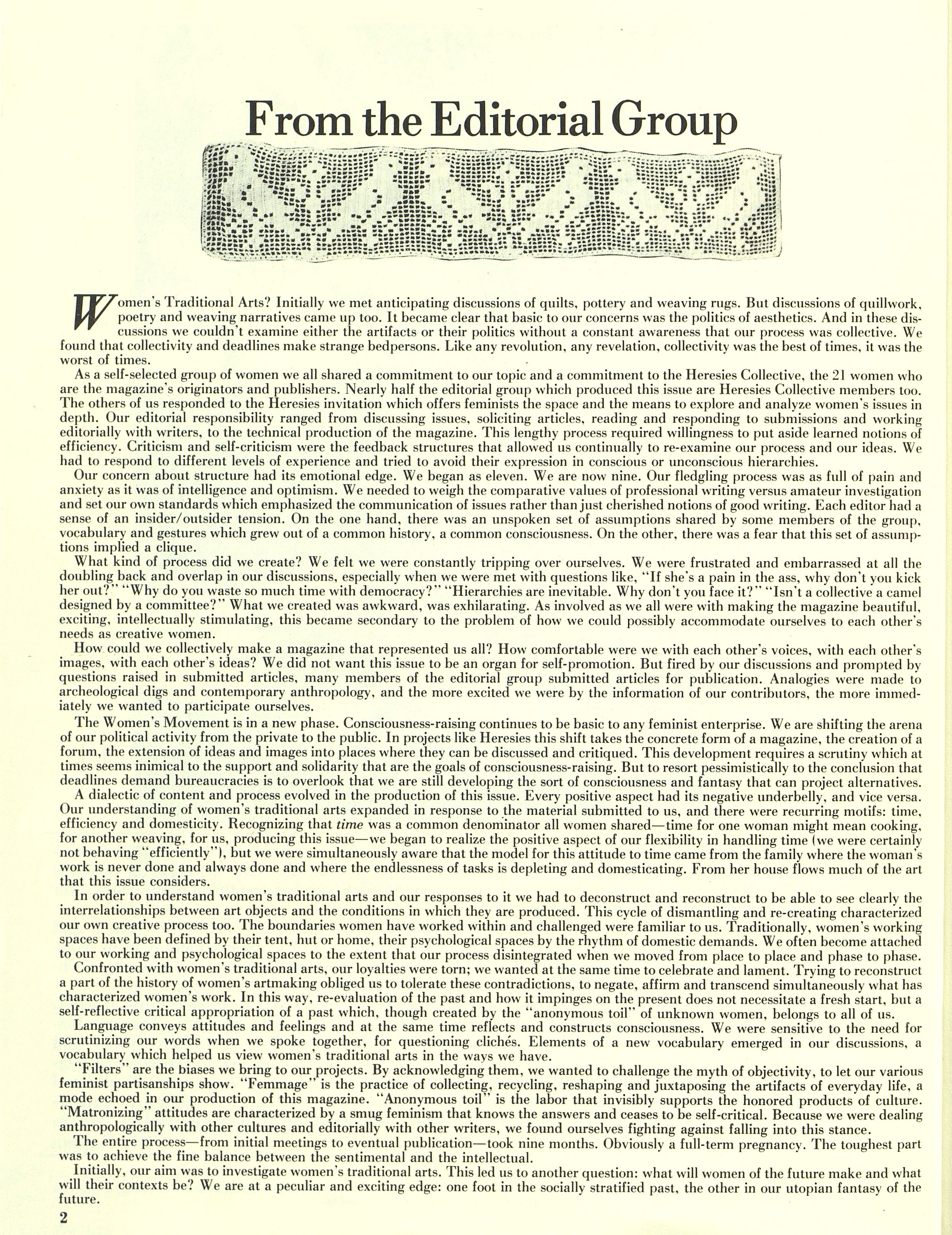Mexican Folk Pottery
Editorial Statement
The Aesthetics of Oppression
Is There a Feminine Aesthetic?
Quilt Poem
Women Talking, Women Thinking
The Martyr Arts
The Straits of Literature and History
Afro-Carolinian "Gullah" Baskets
The Left Hand of History
Weaving
Political Fabrications: Women's Textiles in Five Cultures
Art Hysterical Notions of Progress and Culture
Excerpts from Women and the Decorative Arts
The Woman's Building
Ten Ways to Look at a Flower
Trapped Women: Two Sister Designers, Margaret and Frances MacDonald
Adelaide Alsop Robineau: Ceramist from Syracuse
Women of the Bauhaus
Portrait of Frida Kahlo as a Tehuana
Feminism: Has It Changed Art History?
Are You a Closet Collector?
Making Something From Nothing
Waste Not/Want Not: Femmage
Sewing With My Great-Aunt Leonie Amestoy
The Apron: Status Symbol or Stitchery Sample?
Conversations and Reminiscences
Grandma Sara Bakes
Aran Kitchens, Aran Sweaters
Nepal Hill Art and Women's Traditions
The Equivocal Role of Women Artists in Non-Literate Cultures
Women's Art in Village India
Pages from an Asian Notebook
Quill Art
Turkmen Women, Weaving and Cultural Change
Kongo Pottery
Myth and the Sexual Division of Labor
Recitation of the Yoruba Bride
"By the Lakeside There Is an Echo": Towards a History of Women's Traditional Arts
Bibliography
Women's Traditional Arts? Initially we met anticipating discussions of quilts, pottery and weaving rugs. But discussions of quillwork, poetry, and weaving narratives came up too. It became clear that basic to our concerns was the politics of aesthetics. And in these discussions we couldn't examine either the artifacts or their politics without a constant awareness that our process was collective. We found that collectivity and deadlines make strange bedpersons. Like any revolution, any revelation, collectivity was the best of times, it was the worst of times.
As a self-selected group of women we all shared a commitment to our topic and a commitment to the Heresies Collective, the 21 women who are the magazine's originators and publishers. Nearly half the editorial group which produced this issue are Heresies Collective members too. The others of us responded to the Heresies invitation which offers feminists the space and the means to explore and analyze women's issues in depth. Our editorial responsibility ranged from discussing issues, soliciting articles, reading and responding to submissions and working editorially with writers, to the technical production of the magazine. This lengthy process required willingness to put aside learned notions of efficiency. Criticism and self-criticism were the feedback structures that allowed us continually to re-examine our process and our ideas. We had to respond to different levels of experience and tried to avoid their expression in conscious or unconscious hierarchies. Our concern about structure had its emotional edge. We began as eleven. We are now nine. Our fledgling process was as full of pain and anxiety as it was of intelligence and optimism. We needed to weigh the comparative values of professional writing versus amateur investigation and set our own standards which emphasized the communication of issues rather than just cherished notions of good writing. Each editor had a sense of an insider/outsider tension. On the one hand, there was an unspoken set of assumptions shared by some members of the group, vocabulary and gestures which grew out of a common history, a common consciousness. On the other, there was a fear that this set of assumptions implied a clique.
What kind of process did we create? We felt we were constantly tripping over ourselves. We were frustrated and embarrassed at all the doubling back and overlap in our discussions, especially when we were met with questions like, "If she's a pain in the ass, why don't you kick her out?" "Why do you waste so much time with democracy?" "Hierarchies are inevitable. Why don't you face it?" "Isn't a collective a camel designed by a committee?" What we created was awkward, was exhilarating. As involved as we all were with making the magazine beautiful, exciting, intellectually stimulating, this became secondary to the problem of how we could possibly accommodate ourselves to each other's needs as creative women.
How could we collectively make a magazine that represented us all? How comfortable were we with each other's voices, with each other's images, with each other's ideas? We did not want this issue to be an organ for self-promotion. But fired by our discussions and prompted by questions raised in submitted articles, many members of the editorial group submitted articles for publication. Analogies were made to archeological digs and contemporary anthropology, and the more excited we were by the information of our contributors, the more immediately we wanted to participate ourselves.
The Women's Movement is in a new phase. Consciousness-raising continues to be basic to any feminist enterprise. We are shifting the arena of our political activity from the private to the public. In projects like Heresies this shift takes the concrete form of a magazine, the creation of a forum, the extension of ideas and images into places where they can be discussed and critiqued. This development requires a scrutiny which at times seems inimical to the support and solidarity that are the goals of consciousness-raising. But to resort pessimistically to the conclusion that deadlines demand bureaucracies is to overlook that we are still developing the sort of consciousness and fantasy that can project alternatives. A dialectic of content and process evolved in the production of this issue. Every positive aspect had its negative underbelly, and vice versa. Our understanding of women's traditional arts expanded in response to the material submitted to us, and there were recurring motifs: time, efficiency and domesticity. Recognizing that time was a common denominator all women shared—time for one woman might mean cooking, for another weaving, for us, producing this issue—we began to realize the positive aspect of our flexibility in handling time (we were certainly not behaving "efficiently"), but we were simultaneously aware that the model for this attitude to time came from the family where the woman's work is never done and always done and where the endlessness of tasks is depleting and domesticating. From her house flows much of the art that this issue considers.
In order to understand women's traditional arts and our responses to it we had to deconstruct and reconstruct to be able to see clearly the interrelationships between art objects and the conditions in which they are produced. This cycle of dismantling and re-creating characterized our own creative process too. The boundaries women have worked within and challenged were familiar to us. Traditionally, women's working spaces have been defined by their tent, hut or home, their psychological spaces by the rhythm of domestic demands. We often become attached to our working and psychological spaces to the extent that our process disintegrated when we moved from place to place and phase to phase. Confronted with women's traditional arts, our loyalties were torn; we wanted at the same time to celebrate and lament. Trying to reconstruct a part of the history of women's artmaking obliged us to tolerate these contradictions, to negate, affirm and transcend simultaneously what has characterized women's work. In this way, re-evaluation of the past and how it impinges on the present does not necessitate a fresh start, but a self-reflective critical appropriation of a past which, though created by the "anonymous toil" of unknown women, belongs to all of us.
Language conveys attitudes and feelings and at the same time reflects and constructs consciousness. We were sensitive to the need for scrutinizing our words when we spoke together, for questioning clichés. Elements of a new vocabulary emerged in our discussions, a vocabulary which helped us view women's traditional arts in the ways we have.
"Filters" are the biases we bring to our projects. By acknowledging them, we wanted to challenge the myth of objectivity, to let our various feminist partisanships show. "Femmage" is the practice of collecting, recycling, reshaping and juxtaposing the artifacts of everyday life, a mode echoed in our production of this magazine. "Anonymous toil" is the labor that invisibly supports the honored products of culture. "Matronizing" attitudes are characterized by a smug feminism that knows the answers and ceases to be self-critical. Because we were dealing anthropologically with other cultures and editorially with other writers, we found ourselves fighting against falling into this stance. The entire process—from initial meetings to eventual publication—took nine months. Obviously a full-term pregnancy. The toughest part was to achieve the fine balance between the sentimental and the intellectual.
Initially, our aim was to investigate women's traditional arts. This led us to another question: what will women of the future make and what will their contexts be? We are at a peculiar and exciting edge: one foot in the socially stratified past, the other in our utopian fantasy of the future.

